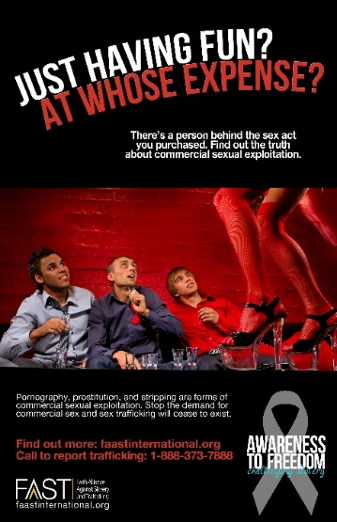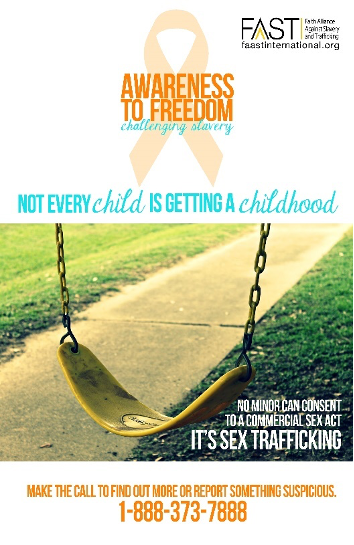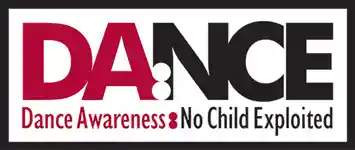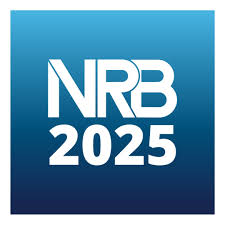For centuries people have been exploited in various ways. Sadly, this includes the hypersexualization of children in dance. What does this mean? This occurs when children are either coerced or encouraged to wear non-age-appropriate costumes, including revealing or sexualized outfits. Another aspect is when the child is made to dance to songs with sexualized lyrics or perform inappropriate moves, including mimicking sex acts. While hypersexualization of dance is not new, we now understand the harms, including body dysmorphia, eating disorders, a higher risk of pornography use, and a higher risk of abusive relationships. DA:NCE Awareness works to educate and bring awareness of these dangers while also educating and promoting dance in a healthy and safe format.

The Faith Alliance Against Slavery and Trafficking (FAAST) is a faith-based organization that also fights exploitation as part of its mission by educating communities and congregations about human trafficking and slavery, partly by exploring what the Bible says about these issues and applying it to our lives today. The following is an example of our work:
Mark 6:14-29 tells of King Herod’s birthday party. It was a lavish banquet complete with entertainment attended by the top officials. The entertainment included a dancer who so mesmerized King Herod he told her she could have anything she wanted, up to half his kingdom. Upon consulting her mother (who was married to King Herod), she asked for the head of John the Baptist as her mother wanted him dead. This story has many similarities to modern-day exploitation, specifically the exploitation of the person and dance.
Mark does not name the dancer, but he does tell us that she was the daughter of Herodias, therefore we know she was Salome. We do not know why she wasn’t named, but one possibility is they were protecting her as she was a minor. The same is done today. The court system and news reports do not name minors involved in crimes, especially in trafficking or abuse cases, to protect them. Performers at strip clubs do the same by adopting stage names to help protect their identity, while also sounding “sexier” to customers.
The dancer’s age is also not revealed; we can deduce she was a teenager based on the language used. The two authors that tell this story both use the Greek word for girl, κορασίῳ, meaning a girl who is still a minor and living with her parents. Mark informs us that she is the daughter of Herodias. Salome’s father was King Herod’s brother, whom Herodias divorced to marry King Herod. This information helps us understand that when this story occurred, Salome was a teenager, some say possibly as young as 12-13. While she is often depicted in her 20s as having autonomy and decision-making ability, that is not the case. She is still very much in the care of her mother. We must keep her age in mind as we examine the rest of the story. Today, while not every stripper is a teenager, research suggests that the median age of strippers is between 23-24 years old, meaning minors are working as strippers.
We cannot say for sure that Salome was a trafficking victim, but we have to consider the following. Her stepfather, her king, presumably made the request for her to dance. Could she have said no? Did she think the request was normal or that she had a choice? More than likely, given her age and audience, she felt she had to perform. The same can be said for many strippers. While not every stripper is a trafficking victim, many are. Traffickers convince them that stripping is a way to work off their debt, but it never happens. Or they coerce them to continue dancing saying they will tell their family, shaming and blackmailing them into staying. These are just two ways traffickers use to keep control of their victims.
What kind of dance did Salome perform? Art has depicted it as the “Dance of the Seven Veils,” a strip tease with the dancer removing veils until only one is left. Others say it was more along the style of belly dancing. Whatever it was, it was a corrupted form of dance that was suggestive and sexualized. This dinner was like a private strip club. Dance is inherently good, but like many things on earth, it has been corrupted and exploited. When dance is sexualized, such as in a strip tease, it makes the dancer a sexual object to the viewer who no longer sees a person with inherent value and dignity.
There is a good possibility that Salome was groomed by both her mother and stepfather. Let’s first start with her mother. In this culture, it was common for mothers to teach their daughters to dance, so more than likely Herodias taught Salome to dance provocatively. Then there is her stepfather, her uncle, King Herod. What was his relationship with Salome? Given he disregarded family boundaries in his sexual/romantic relationship with his sister-in-law, did he do that with his stepdaughter/niece as well? Was this because she performed for her stepfather before, or was there more to their relationship? No matter the reason, a teenager should not feel comfortable performing such provocative moves before anyone, especially a family member.
In the story, Herod was so mesmerized he offered Salome a present of anything up to half his kingdom. Normally presents and gifts are considered a positive thing, but in the case of strippers, when they receive gifts they are taught their worth is found as a sexual object to please the viewer who gives them the gift. This includes patrons either putting money on the stage encouraging them to continue dancing or any tokens the patron gives them.
But harmful dance has harmful outcomes. Research shows that over half of dancers at strip clubs have been threatened with a weapon. One study revealed that 100% of dancers interviewed had been victims of physical assault, including sexual assault at least once while working at a strip club.[1] Traumatic events are sadly a part of this industry.
Despite all the ways dancing has been distorted, the Bible shows us that dancing can be a good thing and should not be vilified. In its purest form, dancing is a beautiful art form used to communicate and express emotions. 2 Samuel 6 gives an example of a pure form of dancing. David is bringing the Ark of the Covenant into Jerusalem. In his joy for finally doing this and His love for the Lord, he danced before the Ark as they entered the city. Interestingly, Michal, David’s wife, reacted to his dancing as if it was wrong saying he humiliated her. David responded by telling her that celebrating before the Lord is not wrong, not even dancing. That is why there was no reason to be humiliated. Several verses speak of dancing as a positive form of expression, normally in times of celebration and celebrating the Lord’s favor. Let us enjoy dance in its true and pure artistic form, as God intended.
At FAAST, we are committed to providing ways for individuals to help educate their community about the dangers of exploitation of all forms, including visiting strip clubs. To help do this, we have created a variety of free posters that help show the dangers of visiting strip clubs. We invite you to download these posters and hang them up in your community with the appropriate permission granted.
Anklesaria, A., & Gentile, J. P. Psychotherapy with Women Who Have Worked in the “Sex Industry”. Innovations in Clinical Neuroscience, 9(10), 27-33. https://www.ncbi.nlm.nih.gov/pmc/articles/PMC3508959/
Bio: Kelly Leary holds a Master’s Degree in Government Affairs from Regent University and authored the paper “Combating Human Trafficking in Turkey” which was published in 2007 in the book A Compilation of Essays for the Abolition of Modern Slave Trade World Wide. Kelly Leary is the Coordinator at the Faith Alliance Against Slavery and Trafficking (FAAST). She loves to travel and has lived in three different countries outside the United States thanks to her husband’s job with the U.S. State Department.





